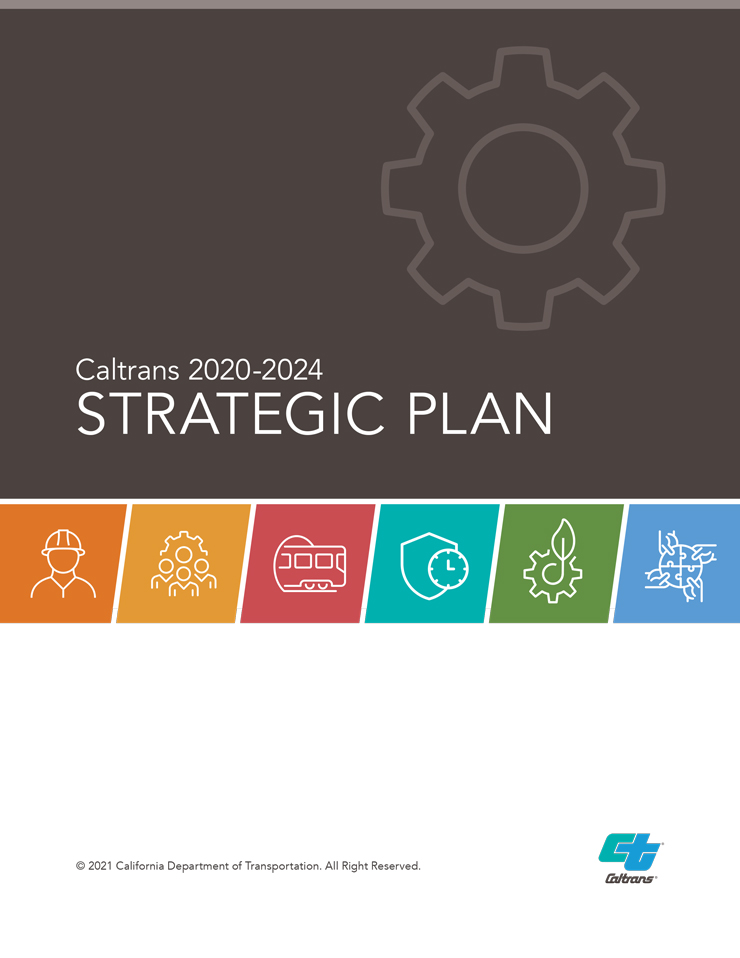Strategic Plan Broadens Caltrans Mission

Safety, Equity, Environment Among Department's Priorities through 2024

Caltrans’ 2020-2024 Strategic Plan, released in March, commits to new core values, offers invigorated mission and vision statements, and sets fresh goals for one of the world’s preeminent transportation organizations. The Caltrans plan also introduces a new element: strategic imperatives.
Strategic planning is a process that Caltrans uses to set a compelling course for the future, identify the actions necessary to arrive at the intended destination, and track performance measures as indicators of progress toward success.
The 2020-2024 plan declares that Caltrans’ core values are engagement, equity, innovation, integrity and pride. Core values represent the traits and behaviors that Caltrans expects of its almost 22,000 employees.
The plan also unveils Caltrans’ new mission statement: “Provide a safe and reliable transportation network that serves all people and respects the environment.”
This new mission statement highlights the importance of safety, equity and the environment to the Department.
The plan also puts forth a vision statement that will serve as the overarching theme for the duration of the 2020-2024 plan: “A brighter future for all through a world-class transportation network.”
As envisioned by Caltrans, “a world-class transportation network” will:
- Be safe, equitable, reliable, efficient, sustainable and resilient.
- Minimize the negative impacts to the environment and enhance the environment where possible.
- Help the economy thrive and give California residents options for their travel needs.
Additionally, three strategic imperatives serve as guiding principles for selecting the course that Caltrans will take to put the plan into action. These strategic imperatives will serve as a “checklist” before making pivotal decisions, asking:
- Will the action(s) improve and expand community partnerships, especially in underserved communities?
- Will these decisions align financial investments to deliver on State goals and Caltrans’ strategic outcomes while maintaining a fix-it-first approach and staying within existing funding frameworks?
- Finally, do they reflect a commitment to equity?
Those broad imperatives serve as the principles behind the six goals developed to define Caltrans’ strategic priorities. They are:
Safety first.
Cultivate excellence.
Enhance and connect the multimodal transportation network.
Strengthen stewardship and drive efficiency.
Lead climate action.
Advance equity and livability in all communities.
In developing the six goals, Caltrans drew from several sources that pointed to the opportunities and threats requiring the most attention. This effort began with an organizational risk assessment that replaced the customary analysis.
In addition, Caltrans relied on surveys of its transportation partners and its own workforce; aligned its conclusions with the California Transportation Plan 2050; and incorporated the priorities of Gov. Gavin Newsom, California State Transportation Agency Secretary David Kim and Caltrans Director Toks Omishakin.
For a national perspective, Caltrans consulted strategic plans from each state’s Department of Transportation.
Each of the six goals includes a group of strategies that represent critical bridges between planning and implementation. A set of performance objectives are attached to each goal that quantifies how well the organization is achieving its desired outcomes, typically stated in terms of “number of” or “percentage of” change.
Performance objectives are not included in Caltrans’ new Strategic Plan. This decision was made because the objectives are often adjusted or replaced over time, which would otherwise require a new version of the Strategic Plan to be published.
Instead, performance targets will be defined and tracked in the companion action plan for the Strategic Plan. The action plan is a document that displays how Caltrans is going to operationalize the Strategic Plan.
Caltrans’ progress toward the targets set for the performance objectives will be listed in the “Mile Markers” dashboard section of the Mile Marker.
Caltrans’ Division of Risk and Strategic Management began working on the 2020-2024 Strategic Plan in 2018, identifying Caltrans’ opportunities and risks, and continued overseeing the plan’s development.
For more information on Caltrans’ 2020-2024 Strategic Plan, refer to the document available on the Caltrans website or email the Division of Risk and Strategic Management at Strategic.Planning@dot.ca.gov.
Source: Blair Thompson, Chief, Caltrans Division of Risk and Strategic Management.

